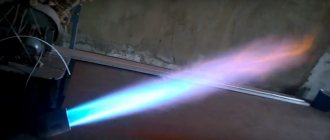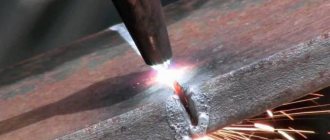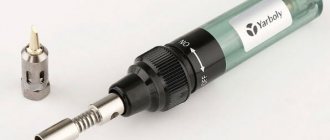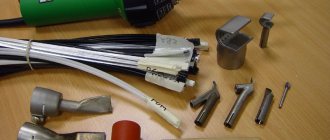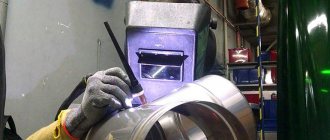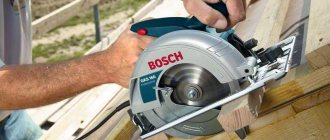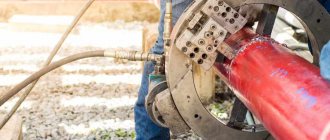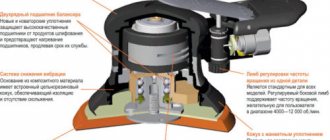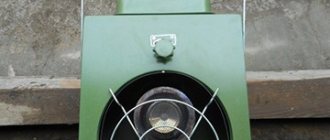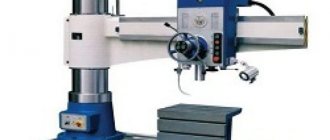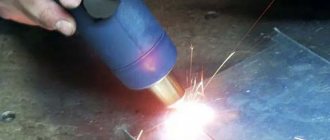Home / Burners for boilers
Back
Published: 06/22/2020
Reading time: 3 min
1
2408
The burner design ensures efficient operation of the boiler and complete combustion of fuel. As a rule, gas burners for domestic and industrial units are sold together with the boiler. This is the optimal solution, since the boiler manufacturer will not only professionally calculate, manufacture and install the burner, but also calibrate its operation.
Such a unit will be ready to work with the best factory settings. In the case when a burner is purchased and installed independently, some difficulties may arise that can disrupt the thermal balance and performance of the thermal energy source.
To prevent this from happening, the owner must carefully select it to match the dimensions of the firebox and the thermal power of the boiler.
- 1 Classification of burners
- 2 How does a gas burner work?
- 3 Operating principle of combination burners
- 4 Operation of household burners
Review of gas burners
When choosing a device, you should take into account its technical characteristics, type of fuel supply, compatibility with other devices and principle of operation.
Several types of burners are popular among consumers. Let's start the review with the modification of the KChM. Most often it is used in boilers converted from solid fuel analogues or LNG. The design is equipped with three nozzles and automation. The second popular type of gas burners is “Hearth”. The device is a pneumatic mechanism with automatic functionality. It has an increased level of security and stops working in the following cases:
- With a lack of traction.
- If the flame goes out.
- Due to a disruption in the natural gas supply.
“Hearth” has a fuel pressure controller, which makes it possible to optimize combustion, even if there are failures in the main system. These models are easy to maintain; soot does not accumulate in the convective compartment.
How to choose?
What you need to pay attention to when choosing a burner device for a boiler:
- productive power - noise level during operation (applies to supercharged models) - type of heating equipment for which the burner is purchased - type of fuel - pros and cons of this device - provide for possible malfunctions in the operation of the local gas supply line.
Taking these factors into account, you can choose the most suitable burner device for your boiler so that it operates as efficiently as possible without the burden of frequent preventative maintenance.
Burners with forced air supply and preliminary preparation of the gas-air mixture
Combination burner GBL-1,2 COMBI
Burners with forced air supply and preliminary preparation of the mixture are most widespread. The gas flow through these burners can be very small (fractions of a cubic meter per hour) and very large (5000 m3/h or more). In burners of this type, it is possible to ensure a predetermined quality of preparation of the mixture before it enters the embrasure or firebox. To speed up the mixing process, gas is most often supplied through a series of slits or holes, the axes of which are directed at an angle to the air flow. When gas jets are supplied into the air flow from the center to the periphery, the burners are called “with central gas supply”, when supplied from the periphery to.
In many burners, air is supplied to the point of mixing with gas in a swirling flow. The most common devices for twisting are: guide vanes with a constant or adjustable blade angle, snail-shaped burner body, tangential air supply to the cylindrical body. In burners for high-capacity boilers, tangential blade swirlers are also used. An increase in the degree of twist intensifies the processes of mixture formation and fuel combustion, but at the same time the burner resistance and energy consumption increase.
Depending on the design of the burner, the quality of mixing gas with air can be very different: in the mixing chamber, the preparation of the gas-air mixture can only begin, ending with the combustion process, or it can be completely prepared for combustion. The mixing chamber of the burner usually has a small volume, and the speed of the mixture leaving the mouth at a rated thermal power is 10-50 m/s.
Combined burners - oil-gas and dust-gas, as a rule, have a forced air supply. The fuel oil nozzle is located along the axis of the burner and, depending on the design adopted, during gas operation it is removed or moved away from the mouth to avoid overheating. To burn fuel oil, air is used, supplied through the same air guide devices that are used when operating on gas fuel.
Based on materials from the book “Combustion of gases in the furnaces of boilers and furnaces and maintenance of gas facilities of enterprises” Chepel V. M., Shur I. A. 1980
Popular varieties
Now let's look at the most common models.
With soldering attachment
This device is intended for heating medium-sized parts, as well as for compact soldering. This occurs due to heating from the sting flame. Such a torch can easily be called a soldering iron without wires. The gas reservoir has a capacity of 8 milliliters. When filling with butane, the flame temperature is 1300 degrees, and the tip temperature is 450. The flame length can be adjusted within 4-6 centimeters. The diameter of the burner is 1.5 centimeters and the length is 13 centimeters.
The price of this model is approximately 400 rubles.
Advantages:
- easy refueling;
- presence of a nozzle for contact soldering;
- the refill is enough to seal several medium-sized parts;
- low price;
- compactness.
Disadvantages: there is no piezo ignition.
Micro burner
There is nothing in this device except a nozzle with a gas supply regulator and a tank with a filling valve. It does not have piezo ignition and is supplied unfilled. In this regard, you will have to additionally purchase a gas can (can be used for lighters). Such a burner is enough to heat heat shrink or solder two wires without a soldering iron. The weight of such a device is 43 grams, and the length is up to 20 centimeters.
The price of the equipment is 200 rubles. This is the cheapest device of this type.
The advantages are the following parameters:
- easy refueling;
- the lowest price.
Flaws:
- there is no piezo ignition;
- the gas station runs out quickly;
- the flame is small.
Mini soldering iron KVT XZ-1
This is a remarkable device from a brand that produces gas equipment. It has piezo ignition. The set includes: 4 soldering tips, a tip cleaning sponge, and a solder spool.
For contact soldering, the stated power of the soldering iron is 137 W. For a soldering iron weighing 120 grams and 21 centimeters long, this is a lot. Electric soldering irons have never even dreamed of such weight and size characteristics. This soldering iron is not positioned as a torch, but it can be used in this capacity - the flame comes out like a pencil.
The price of such equipment is 2300 rubles.
Disadvantages: high price.
Advantages:
- high thermal power;
- good case;
- there is a set of components;
- convenient for soldering;
- famous brand.
Iris Barcelona
This type of equipment is intended for repairing jewelry and electronic equipment, welding and soldering. Its flame is adjustable. You can refill with a regular gas cylinder, which is intended for lighters. The flame can reach a length of up to 3 centimeters, and the temperature can reach 1300 degrees. It can work for approximately 20 minutes. The length of the device is 20 centimeters.
Such a device costs 1,500 rubles.
Advantages:
- brand;
- presence of piezo ignition;
- small dimensions.
Disadvantages: the flame does not allow processing large and medium-sized parts.
Butane torch KVT X-220
Intended for repair and construction work. Looks stylish. The handle is corrugated and pleasant. The flame ignition system is piezoelectric. The capacity of the cylinder for highly purified butane is 22 millimeters. This volume of gas is enough for 110 minutes of continuous operation. The flame reaches a length of 3-8 centimeters, and its shape is adjustable from wedge-shaped sharp to soft with yellow tongues. The device is 14 centimeters long and weighs 226 grams.
Such a device costs approximately 1,600 rubles.
But the advantages are:
- comfortable handle;
- presence of piezo ignition;
- presence of a stand;
- is a good option for desktop work.
Flaws:
- You can’t get into a narrow place;
- large dimensions. Because of this, it will not fit in your pocket.
Manufacturing parameters
Before assembling the burner, you should determine in advance the required parameters, the main ones of which are:
- Flame type – torch or vortex. The design of flameless burners is too complex to make at home. The torch flame affects a small area and is used for precision welding. Using a vortex, you can quickly heat large surface areas.
- Flame adjustment device. The regulator allows you to reduce sludge and increase flow depending on the material and processing method. A water valve can be used for control.
Air-gas injection burners
Burners of this type are called injection, since air is sucked into them (injected) due to the energy of gas jets emerging from one or more nozzles. With a single-nozzle burner, a stream of gas coming from a gas pipeline under pressure is ejected from the nozzle at high speed, as a result of which a vacuum is created in the mixer injector. Due to rarefaction, the surrounding air is sucked into the burner and, when moving along the mixer, mixes with the gas. The gas-air mixture passes through the throat of the mixer (narrow part), which levels out the flow of the mixture, and enters its expanding part - the diffuser, where the speed of the mixture decreases and the pressure increases. After the diffuser, the gas-air mixture enters either the confuser, where its speed increases to the calculated speed, and is supplied through the mouth to the combustion site, or into a manifold with fire holes. Coming out of these holes, the gas-air mixture burns in the form of small bluish-violet torches with an inner cone of greenish-blue color.
Injection burners are divided into medium-pressure burners, capable of injecting all the air necessary for complete combustion of the gas, and low-pressure burners, most often injecting only part of the air, which is called primary. The rest of the air - secondary - enters the combustion zone due to rarefaction in the firebox or due to convection in the atmosphere. Stable operation of medium-pressure burners without flame loss is possible only with the presence of a flame stabilizer. Low pressure burners can operate without special stabilizing devices.
A characteristic feature of the operation of injection burners is the dependence of the primary air consumption coefficient α primary on the vacuum (back pressure) in the furnace. At a constant position of the air damper, α first increases with increasing vacuum, and decreases with increasing back pressure. The greater the pressure of the injection gas, the less this dependence affects: the vacuum (back pressure) in the furnace has the greatest effect on the operation of low-pressure burners, the minimum - on the operation of medium-pressure burners at a pressure in front of the nozzle of more than 0.4-0.5 kgf/cm2.
Some designs of injection burners do not have a diffuser part (injection and mixing occur in a cylindrical mixer) and a control air damper.
Main advantages: no energy consumption for driving a fan to supply air, automatic maintenance of the calculated ratio of the quantities of gas and injected air within certain limits and their good mixing. Disadvantages: limited control range with an α value of about 1, high noise level when using medium and high pressure gas, dependence of injection capacity on the degree of vacuum in the furnace, difficulty in using heated air.
Equipment setup
Floor-standing gas boilers with an atmospheric burner can be configured independently. Pressurized systems are regulated by an automatic control unit and do not require additional configuration.
Scheme of actions for setting up single-stage equipment:
- Install the device on the boiler.
- Connect to the gas pipe.
- Check for absolute tightness.
- Remove the burner housing.
- Using a pressure gauge, measure the gas pressure at the inlet.
- Connect to electricity. Make sure that the jumpers and phases are connected correctly.
- Place a gas analyzer in the chimney pipe.
- Start the device.
- Using a pressure gauge, take pressure readings at the outlet of the burner block. Pressure readings must correspond to the parameters indicated in the data sheet.
- Adjust the air flow using the air damper.
- The gas analyzer readings must also comply with all gas equipment installation standards.
Setting up gas equipment should be carried out by specialists. The simplest open-type boilers can be configured independently if you have certain skills and knowledge of the design of the burner unit. The efficiency of the boiler, its level of efficiency, and fuel consumption depend on the quality of the burner. It is possible to superficially determine that the equipment is malfunctioning by the changed burner flame.
Types of burners
According to their design and functional differences, burner devices are divided into:
By purpose:
- for high power industrial equipment
- for household equipment.
By type of fuel used:
- devices for natural gas;
- devices for liquefied gas;
- universal devices.
By adjusting the flame:
- single-stage – capable of operating on/off;
- two-stage (as a variation - models with smooth modulation) - operate at full power, when the desired temperature is reached, the flame is reduced by half;
- modulating - boilers with a modulating burner are characterized by smooth adjustment of the flame power.
According to the principle of operation:
- injection/atmospheric. They operate by supplying air from the room. They are installed respectively in open combustion chambers. Also used for old-style boiler models.
- fan/supercharged. They work in isolated combustion chambers. Combustion air is supplied by a fan. According to their design features, they are divided into: - vortex (round-shaped nozzle holes) - direct-flow (shape of a narrow slot with a round/rectangular cross-section).
- diffuse-kenetic. Air enters two simultaneously: one is mixed with gas fuel, the second is added directly to the chamber during combustion.
Burner flame
One of the indicators of proper burner operation is the color of the flame. Gas equipment is characterized by an even bluish flame without admixtures of other colors. The presence of yellow or red splashes indicates that the burner is not working well, which reduces the efficiency of the heating equipment.
First of all, this applies to injection burner devices, but sometimes it is also typical for fan burners. The flame may simply lack oxygen. Also, dust and other small debris can get in with the air, which will clog the device, reducing the efficiency of the boiler. All this directly affects the flame. If it hums, the burner is loud, or the fire has changed color, you need to adjust the correct operation of the device.
Principle of operation
Portable mini-gas burners with piezo ignition can be of different designs. For some models, the cylinders may be disposable, while for others they can be removable, and still others even work with stationary ones. Many portable burners have piezo ignition to make starting a fire safe and easy. This device is mainly used for soldering copper pipes or other products made of not very refractory metal. During soldering, different solders are used - liquid or solid soldering acids.
During operation, the mixture contained therein is supplied from the cylinder: acetylene, propane or butane. The gas enters the nozzle and is ignited there. The flow of fire that has formed allows the part to be heated to the required temperature at which soldering will be possible.
A portable mini-torch with piezo ignition can be used for soldering wires, cables, pipes, copper, as well as for repairing electronics with various types of solders. It may also be useful for repairing some parts in the car (radiator and others).
But the scope of application of a device with piezo ignition is not limited to soldering of products. It can also be used in some plumbing work, during corrosion of products or during dismantling to warm up parts.
There are also some non-standard ways to use a portable device. If you like fishing, picnics or hunting, then this device may be useful to you in the field. It can be used to quickly heat up food or start a fire. Using this unit, you can quickly scorch game while hunting.
Application
The scope of use of this equipment is very wide. It can be useful for installing climate control systems, repairing cooling equipment, carrying out plumbing work and other operations. It is often necessary to use this device even when making jewelry. In these cases, one or another type of equipment may be required.
Gas burners are classified according to the following principles.
- According to the method of adjusting the flame - with a power regulator or piezo ignition.
- The nozzles are replaceable, rotating, and resemble a spear.
- According to the scope of application - equipment of a narrow focus and multifunctional.
Application in construction and everyday life
Manual injection burners are used in the repair, construction and household sectors, where an open flame is needed to heat the material. Their versatility is confirmed by a wide range of applications:
- heating and soldering of metals;
- melting of bituminous materials for roof waterproofing;
- firing old paint;
- drying of reinforced concrete panels and casting molds;
- soldering and bending of pipeline systems;
- repair of cable lines;
- fire treatment of animal carcasses and much more.
This device is very easy to assemble and disassemble. Its design allows the use of different nozzles, so one device can be used for various gas-flame work.
Safety regulations
When working with a gas-air burner, you must strictly follow safety rules. First of all, you should carefully select a device, the type of which should correspond to its purpose. During operation, you need to use personal protective equipment and monitor the temperature of the case. In case of excessive overheating, it is better to take a short break.
The picture shows how to check the gas burner before operation
Since gas-air technology involves the use of pressure vessels, they must also meet appropriate requirements. The process of preparing and filling propane cylinders is very similar to filling vessels with welding mixture, which can be read about in the article: filling with welding mixture: how it is done.
High-quality gas for flame processing can be purchased at. On this site you will receive professional service and technically correct refilling of propane cylinders.
Design features of the gas burner
This element of the unit creates a stable flame; it is in the burner that the fuel entering the device is burned. Then the resulting heat moves upward, where there is a heat exchanger through which the coolant liquid moves. Combustion products and excess heat escape into the atmosphere in one way or another.
The gas burner has a simple design; it consists of several main components, including:
- Nozzle – used to release gas.
- Ignition system – designed to ignite gaseous fuel.
- A sensor that monitors the presence of a burning flame.
- Automation system – monitors temperature indicators.
This is how the design looks simplified.
Modern gas burners for heating boilers are devices that must meet a number of requirements:
Quiet operation. Is an important quality. Many consumers are familiar with Soviet-era instantaneous water heaters, in which the flame made a lot of noise. But modern models operate relatively quietly. Also, when choosing a device, you should pay attention to the ignition, since there should be no explosions or pops. The noise level is additionally affected by the design of the combustion chamber.
Long period of operation In older models of gas units, burners worked for a long time, since at that time the equipment was made to last. Nowadays such technologies are not used, so these elements installed in gas boilers break down quite often. In this case, experts recommend purchasing devices manufactured under well-known brands, for which they use high-quality components. You should not buy Chinese equipment of unknown manufacture and cheap domestically produced boilers, since they often have short-lived burners installed.
Complete combustion of gaseous fuel
This is an important requirement, since the burner must burn natural gas completely with minimal release of combustion products and other associated compounds, including carbon monoxide. The degree of combustion is also affected by other components
We should not forget about arranging high-quality gas removal - for this you need to make a chimney that has good draft.
The operating principle of a gas burner is simple:
- The unit detects the presence of a discrepancy between the temperature in the heating circuit and the indicators specified by the equipment users.
- After opening the gas valve, fuel enters the burner.
- At the same time, the ignition system is activated.
- Once the gas is ignited, a flame appears.
At the same time, the flame sensor starts working, which monitors its presence: if the fire suddenly goes out, the automation shuts off the fuel supply. Once the heating system reaches the required temperature, the gas supply stops.
In what cases is it necessary to adjust the burner flame?
An atmospheric gas burner for heating equipment often fails. It is equipped with models of both wall-mounted and floor-standing boilers. The injection burner of floor-standing equipment reduces its efficiency for various reasons:
- Burner power is too high. This happens when a high-power burner is purchased for small heating equipment. At the same time, there is not enough space for combustion, the air flow for such power is weak, which leads to the transition of the flame from blue to yellow, sooting of the combustion chamber and chimney.
- If the chimney is poorly cleaned, the boiler draft deteriorates. At the same time, waste combustion products are poorly removed, and the air flow is small. This worsens combustion and the flame turns yellow.
- A defect in the burner itself does not make it possible to correctly adjust the complete combustion of the fuel.
- Due to pressure changes in the gas supply system, well-regulated equipment can release large amounts of unexhausted gas into the chimney. Partially it settles with soot and soot. A large layer of soot reduces traction and increases fuel consumption.
- Starting heating equipment after repair.
- The presence of extraneous noise during operation of the boiler or gas burner.
- Changing the type of fuel.
You may be interested in learning about the operating principle of a double-circuit gas boiler >>>
Types of burner ignition
A modern instantaneous gas water heater is produced with automatic ignition and a manual pilot ignition system.
For economic reasons, manual ignition is unprofitable. The system consists of a piezoelectric element activated by pressing a button. Pressing a key produces a spark that ignites the igniter. The operation is simple, but the igniter constantly burns throughout the day, consuming gas. It is irrational to turn it off, since you will often have to re-ignite it when you need to consume hot water.
Auto-ignition occurs immediately after opening the hot water tap:
- The first operating principle of electronic ignition is based on batteries. The waiting igniter does not light. When the mixer tap is opened, the pressure in the water supply changes and the sensor gives a signal to the electronic unit to ignite. The energy from the batteries creates a spark. The flame lit on the igniter ignites the burner. Having done its job, the igniter turns off until the next start. Battery ignition does not require much energy. The battery charge lasts for a year.
- The second operating principle of auto-ignition is based on a hydrogen generator. The instantaneous gas water heater is equipped with a turbine instead of batteries. It is driven by the flow of water created in the water supply when the mixer tap is opened. The hydrogenerator produces a spark that ignites the igniter.
Gas water heaters with automatic ignition are beneficial due to lower gas consumption and ease of use.
Gas oven thermostat
In order for the oven to work correctly and food to cook within the specified temperature range, a thermostat or thermostat is installed inside the cabinet. They can be mechanical, electromechanical, or electronic; to control a given mode, a rotary knob, button, or other, more complex and highly accurate devices are used. What is a thermostat in a household gas stove and how does it regulate the operating mode of the oven?
Gas stove thermostat diagram:
Diagram of a dilatometric oven thermostat: 1 - tubular rod; 2 - movable wedge; 3 - ball; 4 - pusher; 5 - spring-loaded valve; 6 - spring.
How does a gas oven thermostat work?
The operating principle of such a thermostat is very simple. The dilatometer, which records the temperature increase in the oven, heats up, causing the linear rod to expand. It activates a mechanism that ultimately acts on the spring-loaded valve. The stronger the heating inside the oven, the further the spring-loaded valve will move and close the gas supply hole. Accordingly, as the temperature decreases, the linear rod decreases and the system works in the reverse order, opening a larger hole for gas access and increasing the temperature inside the oven.
Gas oven thermostat
The maximum temperature inside the oven is limited by a switch knob installed on the front panel of the gas stove.
How to check if the thermostat is working
Having figured out what a thermostat or temperature controller is in a gas stove, you need to make sure that this device is working properly.
Significant errors in the instrument readings can ruin any culinary masterpiece. In one case, the food will simply burn, in the other, it will remain raw. To check the thermostat, it is best to invite a specialist who, using precision instruments, will identify any deviations in temperature readings, up to 1 °C. If this is not possible, and a difference of 3-5 °C is not of great importance, you can check it yourself:
- Turn on the oven at 150°C;
- Place a mechanical thermometer inside the oven, designed to measure temperatures in the appropriate temperature range;
- Leave the oven on for 20-25 minutes until the temperature reaches the desired level;
- After 20 minutes, check the temperature readings on the thermometer and thermostat. If the difference in indicators exceeds 5-10 °C, the temperature controller needs to be repaired.
Important: to repair a gas stove, you must invite a specialist, since the problem may not only be a damaged thermostat, but also noticeable heat loss due to a loose door
Features and history of creation
The first gas stove was invented back in the century before last, shortly after the general gasification in England. One of the gas factory workers named James Sharp was the first to think about using gas for cooking. It was he who, in 1825, designed the first analogue of a modern gas stove and installed it at home, significantly simplifying his life.
10 years later, factory production of such devices began, however, at first accidents often occurred, since people were not yet accustomed to the fact that gas must be handled very carefully
The period from 1837 to 1848 saw the evolution of the gas cooking appliance. The first models created by de Merle were not perfect enough. Afterwards they were improved by d'Elsner, who was an inventor. All these models still did not bear much resemblance to modern ones. But in 1857, the most advanced model of that time was invented by de Beauvoir, and it was this design that subsequently formed the basis for the creation of gas stoves for many years.
On the territory of Russia, stoves appeared only in the 30s of the last century, since mass gasification began after the revolution. However, the new devices were mainly used in apartments rather than private homes
Gas-powered units significantly saved housewives’ time, so they considered this feature a good compensation for the need for careful handling. Modern modified gas devices have a number of features
Among them there are both fairly new characteristics and those that were characteristic of all previous models.
- This unit only runs on gas. Therefore, it is necessary to either connect it to the general gas supply system, or supply fuel from a cylinder.
- A characteristic feature is the low cost of operation of this device. Even if you cook a lot, you won't have to pay a big utility bill because gas is cheap.
- A gas stove performs 3 main functions for cooking. It allows you to cook, fry and bake foods (if you have an oven).
- In most cases, the stove requires a hood, since sometimes the gas on which the device operates has a specific odor.
- A negative feature of the device is the need for extremely careful and attentive handling of it. Otherwise, there is a possibility of a gas leak, which could cause an explosion in the living space and tragic consequences.
- In the modern market of household appliances, gas stove models are presented in various embodiments.
Typology
The market offers a variety of gas cylinders for burners. The selection of a highly specialized or universal tool is determined by the requirements of the tasks:
- Activation time for one-time operations;
- The need to create a certain temperature;
- The amount of air involved in fuel combustion: diffusion, injection with full/partial mixing with air in front of the outlet;
- Control of the combustion process, temperature increase/decrease;
- Weight and dimensions of the complete device, grip;
- Volume and type of cylinders, connection method;
- Calorific value of the combustible mixture;
- The gas burner on the canister has piezo ignition and a clamp to keep the valve in working condition.
Tourist
The simplest device according to the requirements is a burner for cooking and heating a tent. The butane filler provides a temperature of 800–1000 C. There are 3 types of placement of the heating object:
- Installation directly on a cylinder with a wide base;
- Side connection;
- Removed via flexible hose.
Installation on a kerosene stove-type cylinder is compact, but the technical solution causes criticism:
- The load on the body is high;
- Instability of combustion, blowing out of fire by wind;
- Instability of the structure;
- Inadmissibility of installing wind protection;
- The case may overheat.
Important! Overheating of the cylinder body can lead to an explosion.
The stability of the structure allows installation on unprepared soil
Remote hose placement is fire safe. The fireplace can be protected with wind shields. The combustion intensity is adjusted using a gearbox.
Artificially pressurized lamp
Injection gas burners for a can with piezo ignition and additional air intake are suitable for melting, soldering with copper, refractory fluxes, and heat treatment. The variety of tools includes miniature ones for jewelers and decorators, solid ones for long-term use with high consumption of flammable substances.
Fundamental differences determine the caloric content of the fuel and the exit front of the pre-air-enriched mixture from the nozzle. A narrowed dagger torch is necessary for high-temperature soldering.
Expanded – replacement of the forge, hardening furnace.
The power of a gas blowtorch ranges from 1.5–3 kW. The conditional division into professional and amateur models is reflected in the cost. Filling the cylinder up to 0.5 liters with many hours of use.
Focused supply of thermal energy leads to fuel savings. The set includes several nozzles of different orientations and flame concentrations. Changing the nozzles turns the tool into a microcircuit soldering iron or micro-cutter.
Pencil-type burners have a built-in container that must be refilled from a standard cylinder. The hose extension will allow you to use a container from the retail chain.
Soldering iron
A gas soldering iron is less often equipped with a piezo ignition. The temperature balance is lower and the scope of application is narrower. But mastering technical skills is easier. In half of the cases, preliminary mixing of gaseous media is not provided.
The concentration of the torch core is not provided. Long-term heat treatment of large areas does not threaten the cylinder with overheating by the reflected heat flow due to the elongation of the gas supply tube and the dispersion of the flame.
Cutter
A gas torch is suitable as a substitute for a blowtorch if you expand and lengthen the torch. Soldering iron for refractory solders when focusing the core by installing a nozzle with a swirling flame.
Gas equipment
Fuel containers vary in configuration, size, filling volume, and composition of the combustible mixture. The main difference in the fastening method:
- Threaded, European standard - external thread, US standard - increased diameter.
- Collet.
- With internal valve.
- Pierceable.
Standardized thread is the preferred option. The burner or extension hose is screwed onto the neck. A fuel leak is unlikely. The connection is reliable.
The valve-type cartridge prevents gas loss. The connection with the burner or extension cord is made by forcefully pressing and then turning the lock until it stops.
Punctureable balloons are less common. The inconvenience is that before the cylinder is empty, disconnecting the burner is impossible without losing the contents.
Adapters allow you to universally use cylinders of any type and design for the purchased equipment. A pair of adapters will eliminate difficulties with selection and articulation.
TOP 7 best modifications
Hot water burners operating on the principle of burning a mixture of air and propane-butane are called portable torches. They operate from a gas cylinder, are affordable, have a simple design, compact dimensions and light weight, and do not cause any difficulties in operation.
Due to their reliability, safety and fairly high efficiency, mobile burners are widely used not only in construction. They are used to solve all kinds of household, economic, and industrial problems.
The principle of operation of the equipment is simple: a flammable substance under pressure is supplied to the valve through a hose, enters the mixing zone with air, after which the nozzle releases a flame onto the surface to be treated through a glass (mouthpiece)
Despite the general similarity, burners differ in certain features, technical characteristics, can be equipped with additional functions, and have a narrower or broader purpose.
One of the compact types of equipment are gas burners on a can, which are attractive due to their small size and mobility. To solve one-time problems, manufacturers have offered a number of mini burners, which find a wide range of applications in everyday life.
Each model has its own advantages and disadvantages. The products are used in almost all types of work where there is a need to heat the material.
Based on reviews from real users and opinions of industry experts, we have selected the seven best modifications produced by various foreign and domestic manufacturers.
1st place - DONMET GV 231
One of the universal models of the autogenous equipment plant, intended for economic and domestic work. The cost of a product positioned as an economy class varies between 800-900 rubles.
The handle of the device is made of durable wood. It is convenient to work with it for a long time. An improved valve extends the service life of the device and ensures its maintainability
Performance characteristics:
- device weight – 0.3 kg;
- product length – 40 cm;
- flammable substance – methane/propane;
- gas consumption – 1-1.3 m³/h;
- working pressure – 0.07-0.2 MPa;
- input connection – 0.6 cm;
- glass diameter – 3.5 cm.
Thanks to the improved design of the mouthpiece, the burner has increased resistance to wind, is lightweight, and ensures complete combustion of fuel. The principle of its operation is no different from similar models. It is based on the suction of external air and forced gas supply.
Using the open flame generated by the burner, metal elements are heated, reinforced concrete panels and brickwork are dried, polymer pipes are bent, and bituminous materials are melted.
Maximum heating temperature – up to 700 °C. The heat flow power in the device is 9.6/23.2 kW, which depends on the type of gas used.
Among the disadvantages of the burner, a limited radius of work is noted due to the short length of the gas supply tube. However, it is worth considering that compact dimensions provide additional advantages when processing hard-to-reach areas.
2nd place - KRASS GV-100-R
The burner of the Russian brand is produced with a lever fuel supply system, thanks to which it is possible to operate in an economical “standby” mode. The average cost of a product on the market is about 700 rubles.
The gas supply lever is located in such a way that it can be easily adjusted with one hand. The handle is made of heat-resistant plastic. The convenient shape of the handle greatly facilitates the work process
Performance characteristics:
- device weight – 0.37 kg;
- product length – 51 cm;
- flammable substance – propane-butane mixture;
- gas consumption – 0.57 m³/h;
- working pressure – 0.15 MPa;
- input connection – 0.63-0.9 cm;
- glass diameter – 3.5 cm.
An injection-type burner is used for heating and soldering workpieces made of ferrous/non-ferrous metals, drying casting molds, and firing old paintwork at home or in production.
The device is often used for indirect purposes. For example, heating car engines at low external temperatures, singeing animal skins in agriculture.
In general, users characterize the burner as a durable, wear-resistant and easy-to-use device. It provides instant heating, has optimal weight and dimensions, and is made of high-quality steel and brass. No significant disadvantages were noticed in this model.
3rd place - Sievert Turboroofer 60
The SIEVERT turboroofer model is a professional hot water burner made in Estonia. Its price is much higher than other devices participating in the rating, and is about 4,000 rubles.
This amount is justified by the absolute safety, high power and reliability of the equipment, which can be used to ensure the uninterrupted operation of various processes in construction and industry.
The device has several combustion modes - pilot, working, pulsating, constant. The package includes a handle with a regulator, a curved tube, a nozzle and a stand.
Performance characteristics:
- device weight – 0.92 kg;
- product length – 80 cm;
- flammable substance - propane;
- gas consumption – 8.25 m³/h;
- working pressure – 0.4 MPa;
- input connection – 0.6-0.9 cm;
- glass diameter – 6 cm.
A special feature of the device is an improved wind protection system, which provides significant advantages when performing welding work in difficult weather conditions. The burner creates a powerful flame flow, which is controlled by two valves and a trigger that switches operating modes. The heat flow power in the equipment reaches 140 kW.
The body is made of stainless steel and special materials with zinc coating. The reduced weight of titanium tips helps reduce the load on the body during painstaking, lengthy work.
The SIEVERT torch is considered one of the most ergonomic tools in its category.
The model is designed for heating roofing materials before melting, drying surfaces, various road, waterproofing and other large-scale works that require a powerful flame. The only drawback is the high cost.
4th place - Svarog GV-111
A manual valve-type injection burner from Svarog helps to cope with almost all types of work that require gas-flame processing - heating and soldering surfaces, drying roofs, fusing materials, repairing joints and abutment points of the roof, stripping off old paint.
The approximate price of the product is 500-600 rubles.
The convenient location of the valve makes it easy to regulate the gas supply. The plastic handwheel has arrows indicating the direction of rotation when opening/closing the valve block. This eliminates the possibility of making mistakes during adjustment
Performance characteristics:
- device weight – 0.42 kg;
- product length – 93 cm;
- flammable substance - propane;
- gas consumption – 2.2 m³/h;
- working pressure – 0.25 MPa;
- input connection – 0.6-0.9 cm;
- glass diameter – 5 cm.
The burner is equipped with a practical handle made of composite polymer materials, which are characterized by high fire resistance and strength. Good combustion power is achieved due to the well-thought-out design of the device.
The disadvantages of the product include a fairly high gas consumption and the lack of piezo ignition.
5th place - Foxweld Corundum GVP-1000R
The hot water burner model of the Italian brand is an example of excellent quality and good functionality. It costs about 800-1000 rubles.
The burner produces a stable flame with a temperature of 1100 to 1900 °C, which is controlled using a lever. Such a mechanism allows you to accurately control the amount of gas, the length of the flame, switch the device from operating to standby mode, adjusting the strength required at the current moment. Maximum heat flow power – 80 kW
Performance characteristics:
- device weight – 0.66 kg;
- product length – 100 cm;
- flammable substance – propane-butane;
- gas consumption – 4.5 kg/h;
- working pressure – 0.1-0.2 MPa;
- input connection – 0.6-0.9 cm;
- glass diameter – 6 cm.
The device is equipped with a large nozzle, which allows for large-scale roofing work. The tool is indispensable in the repair and construction of roofs and suspended structures; it is used for soldering, heating, drying and melting materials.
It is also used for road work and grass burning. Due to the sufficient length of the hose, it covers a fairly wide radius. The main structural parts of the device are made of metal and stainless steel. It is convenient to work with this burner while standing at full height.
Subject to all operating conditions regulated by the manufacturer, the equipment will last a long time even with regular use. It comes with a 12 month warranty. No significant disadvantages have been identified with the Foxweld hot water burner.
6th place - REDIUS GV-211-R
The burner of the Russian brand Redius is characterized by users as an effective, reliable and safe device for fire processing of various materials. The product costs about 800 rubles.
The torch is most suitable for soldering and heating metal products, stripping work, and fusing rolled bitumen materials. The increased length of the hose makes it easier to perform various types of work in hard-to-reach areas and at heights
Performance characteristics:
- device weight – 0.59 kg;
- product length – 90 cm;
- flammable substance - propane;
- gas consumption – 5 m³/h;
- working pressure – 0.02 MPa;
- input connection – 0.6-0.9 cm;
- glass diameter – 5 cm.
The model belongs to the line of high-power roofing burners, presented in a lever version. It is equipped with a durable design, adapted to use in harsh conditions, a practical curved shape, and an easy-to-maintain removable cup.
In addition to the equipment, you can purchase components for more comfortable and safe operation. For example, the manufacturer Redius produces special stands for hot water burners. Among the disadvantages of the GV-211-R burner is the significant consumption of combustible materials.
7th place - BAMZ GVM-1
The injection hot water burner of the Russian brand is easy to maintain and operate. The universal device is used in road and roofing work, for melting ice and removing weeds, repairing cable lines, and heating seams before welding. The average price of a product on the market is about 1200 rubles.
The recommended external temperature range during burner operation is from -15 to +45 °C. The safety of the equipment is confirmed by declarations of conformity. The model is equipped with an additional stand, which is attached to the tip with screws at a certain distance from the glass
Performance characteristics:
- device weight – 0.8 kg;
- product length – 90 cm;
- flammable substance – propane/methane;
- gas consumption – 0.7-1.5 m³/h;
- working pressure – 0.1-0.3 MPa;
- input connection – 0.6-0.9 cm;
- glass diameter – 5 cm.
The burner ensures complete combustion of gas and provides the ability to operate on methane. The elongated design allows you to work comfortably at full height without unnecessary movements. The intensity of the flame is regulated by a convenient lever adjacent to the handle of the device. Heating temperature – up to 500 °C.
The list of disadvantages of the burner includes difficulties with igniting and adjusting the flame, thickening of the fuel mixture in very frosty weather. However, this drawback is inherent in almost all devices in this category.
